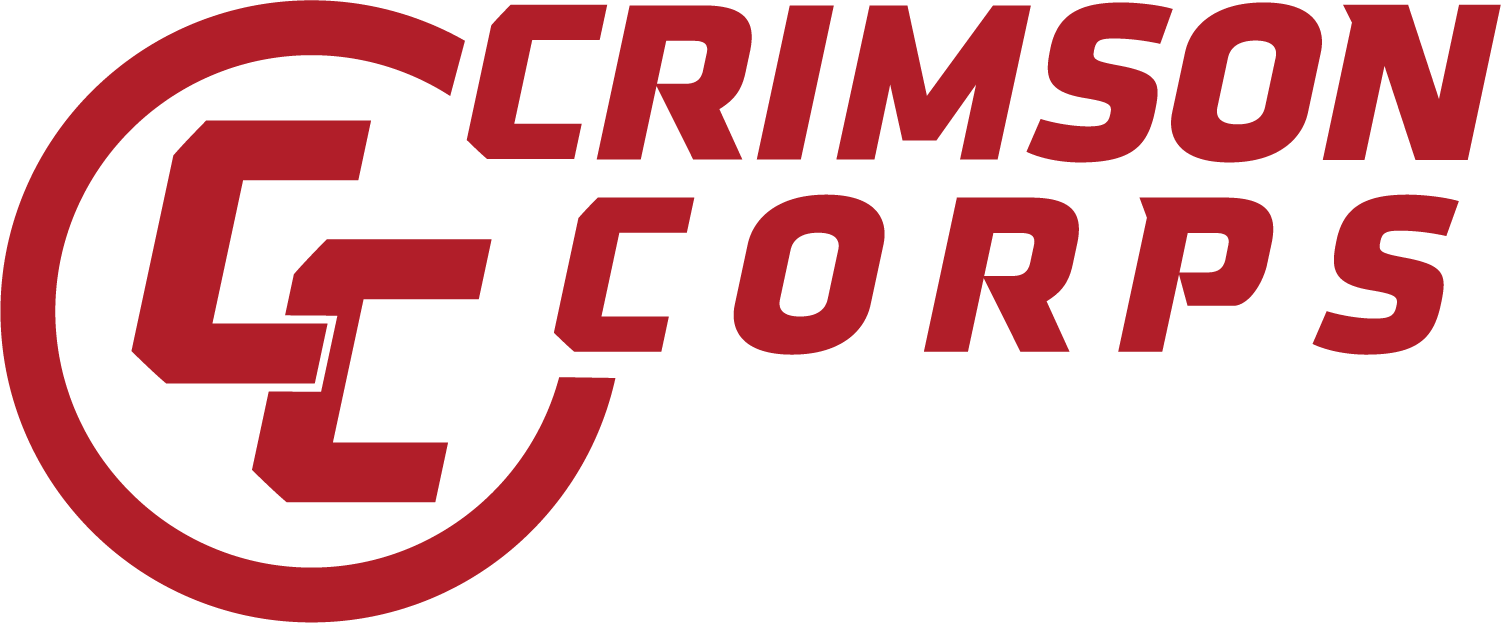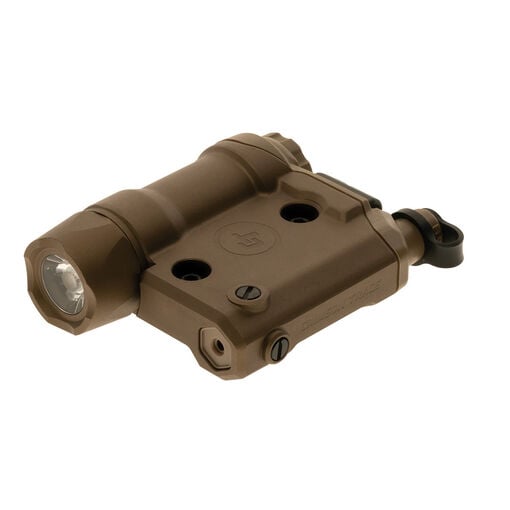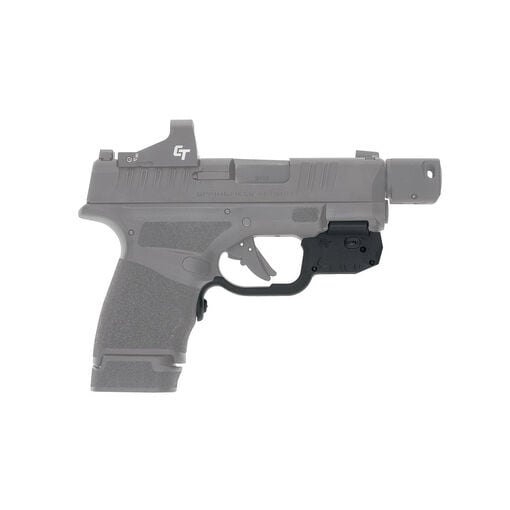by Jeremy Stafford
In today’s society, it’s easy to fall into the trap of attempting to purchase skill, especially if one believes everything they read on the web. So, when you are purchasing a laser sight device for your firearm, remember that as great as laser sights are, they’re not going to fix a bad trigger pull or a sloppy draw.
Laser sights simply provide a different aiming option, sometimes better, sometimes worse, depending on the tactical scenario that the shooter is presented. They need to be treated like any other new piece of equipment. You have to learn how they work, how to maintain them and, especially, how to use them.
Let’s talk about some of the training exercises that you should incorporate into your practice sessions if you’re serious about maximizing the potential of the pistol-mounted laser sight.
Laser sights simply provide a different aiming option, sometimes better, sometimes worse, depending on the tactical scenario that the shooter is presented. They need to be treated like any other new piece of equipment. You have to learn how they work, how to maintain them and, especially, how to use them.
Let’s talk about some of the training exercises that you should incorporate into your practice sessions if you’re serious about maximizing the potential of the pistol-mounted laser sight.
Presentation and Awareness
First thing to do is to work on your presentation from the holster. While the physical mechanics are unchanged, what the shooter’s eyes need to do is very different. The eyes need to be trained to the point of unconscious competency (i.e., doing it without thinking about it). As the pistol is drawn and the eyes change focus from the threat to the sights, a very coarse sight picture is obtained.
By coarse, I mean that it is a brief flash sight picture, not directly focusing on the sights, but rather gathering enough information to ensure that the pistol is indeed pointed at the target. Think of it as a basic awareness of the sights. Once this brief verification has been obtained, then the focus returns to the threat, and the visible laser becomes the point of focus.
If there is no visible laser dot, do not start searching for it. At that point in the fight, you are losing too much time. Simply return focus to the front sight and continue as you would without a laser sight. If you start trying to search for the dot, you’ll end up chasing it all over the place instead of getting well-aimed shots on target.
While this sounds like a long, involved process, it actually happens in a fraction of a second. The best way to start training this is with dry-fire practice, starting at a consistent, repeatable pace and then speeding up as your skill level allows.
The eye can focus and the brain can process information at unbelievable speed, you simply have to allow the skill to develop. Once you feel comfortable with the process, start sending live rounds downrange. I recommend using a timer so that you can see exactly where your speed is.
By coarse, I mean that it is a brief flash sight picture, not directly focusing on the sights, but rather gathering enough information to ensure that the pistol is indeed pointed at the target. Think of it as a basic awareness of the sights. Once this brief verification has been obtained, then the focus returns to the threat, and the visible laser becomes the point of focus.
If there is no visible laser dot, do not start searching for it. At that point in the fight, you are losing too much time. Simply return focus to the front sight and continue as you would without a laser sight. If you start trying to search for the dot, you’ll end up chasing it all over the place instead of getting well-aimed shots on target.
While this sounds like a long, involved process, it actually happens in a fraction of a second. The best way to start training this is with dry-fire practice, starting at a consistent, repeatable pace and then speeding up as your skill level allows.
The eye can focus and the brain can process information at unbelievable speed, you simply have to allow the skill to develop. Once you feel comfortable with the process, start sending live rounds downrange. I recommend using a timer so that you can see exactly where your speed is.

Lighting And Distance
Another consideration when training pertains to your lighting conditions. When you first start training with a laser, the compulsion to train only in limited light will be strong. Ignore that little voice and make sure that you train in all lighting conditions. It is important that you know the range that you can effectively use your laser sight in bright daylight conditions and that you understand your capabilities at those distances.
Being a good guy often means being reactive rather than proactive, and we rarely get to dictate the circumstances of the fight. Even if you are in diminished light, realizing that the ability to see your laser at 30 yards does not automatically mean that you can hit that target. That’s going to take work on your fundamental skills, like having a solid trigger pull, followthrough and even breathing control. Don’t get so caught up in the technology that you forget the fundamentals.
If you’re going through the time and energy to mount and train with a laser sight, then you should start training in techniques where the laser sight will give you an immediate benefit.
One of the techniques that comes to mind is shooting on the move. Misses while shooting on the move are just as often the result of a poor trigger squeeze as they are misaligned sights. But in my experience, the feedback of the laser sight on the target often keeps the shooter from breaking a shot before they should, resulting in a higher percentage of shots on target. The laser sight also shows its effectiveness when training against targets that actually move.
I’ve conducted and participated in hundreds of force-on-force training sessions using Simunitions or other marking cartridges, and shooters using laser sights have turned in a higher number of hits in low-light scenario training in the vast majority of times. Force-on-force training against aggressive threats in low light must be a part of every intelligent training program, and a quality laser sight should be a part of that.
Being a good guy often means being reactive rather than proactive, and we rarely get to dictate the circumstances of the fight. Even if you are in diminished light, realizing that the ability to see your laser at 30 yards does not automatically mean that you can hit that target. That’s going to take work on your fundamental skills, like having a solid trigger pull, followthrough and even breathing control. Don’t get so caught up in the technology that you forget the fundamentals.
If you’re going through the time and energy to mount and train with a laser sight, then you should start training in techniques where the laser sight will give you an immediate benefit.
One of the techniques that comes to mind is shooting on the move. Misses while shooting on the move are just as often the result of a poor trigger squeeze as they are misaligned sights. But in my experience, the feedback of the laser sight on the target often keeps the shooter from breaking a shot before they should, resulting in a higher percentage of shots on target. The laser sight also shows its effectiveness when training against targets that actually move.
I’ve conducted and participated in hundreds of force-on-force training sessions using Simunitions or other marking cartridges, and shooters using laser sights have turned in a higher number of hits in low-light scenario training in the vast majority of times. Force-on-force training against aggressive threats in low light must be a part of every intelligent training program, and a quality laser sight should be a part of that.

Unconventional Positions
Lastly, let’s look at an overlooked advantage to using a firearm-mounted laser sight — the ability to engage targets from unconventional positions.
Like I said before, just because you have the ability to put the dot on the target doesn’t mean you have the skill to put the bullet on the target — that takes work. Practice sessions with the laser sight should take advantage of the ability to shoot effectively around cover without exposing more of your body than necessary. They should also take advantage of the ability to shoot effectively from the prone and supine positions.
Keep in mind, we’re not always in control of when the fight happens; likewise, you may not always be in control of when you get knocked down or injured. The laser sight can be helpful in these situations, but only if you’ve put the work in.
Laser sights are not a solution to every problem, but if the situation arises that you need it, you’ll be glad you have it. Skill doesn’t happen by itself. Get to the range and put the work in. That way, if the fight ever finds you, you’ll never have to wonder if you did enough to protect yourself or your loved ones.
Like I said before, just because you have the ability to put the dot on the target doesn’t mean you have the skill to put the bullet on the target — that takes work. Practice sessions with the laser sight should take advantage of the ability to shoot effectively around cover without exposing more of your body than necessary. They should also take advantage of the ability to shoot effectively from the prone and supine positions.
Keep in mind, we’re not always in control of when the fight happens; likewise, you may not always be in control of when you get knocked down or injured. The laser sight can be helpful in these situations, but only if you’ve put the work in.
Laser sights are not a solution to every problem, but if the situation arises that you need it, you’ll be glad you have it. Skill doesn’t happen by itself. Get to the range and put the work in. That way, if the fight ever finds you, you’ll never have to wonder if you did enough to protect yourself or your loved ones.



